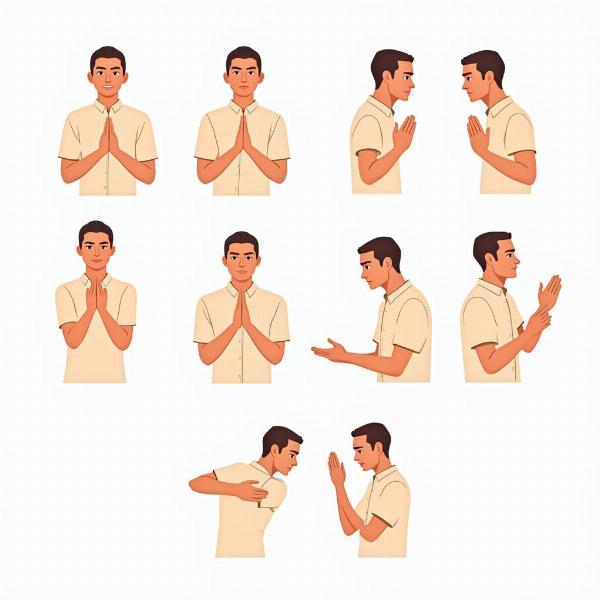Understanding the meaning of “body movement” in Hindi is essential for anyone navigating the nuances of Indian culture, communication, and artistic expression. Body language plays a significant role in Indian society, conveying emotions, respect, and social cues. This article will explore various Hindi terms related to body movement, their cultural context, and how they contribute to effective communication.
Exploring Hindi Words for Body Movement
Several Hindi words capture the essence of “body movement,” each with its unique connotations and applications. Let’s delve into some of the most common terms:
- Sharir Gati (शरीर गति): This is a formal and literal translation of “body movement,” suitable for scientific or technical contexts. It encompasses all forms of physical motion, from simple gestures to complex dances.
- Angsanchalana (अंगसंचालन): This term emphasizes the movement of limbs and body parts, often used in yoga, exercise, and physical therapy. It focuses on the controlled and deliberate motion of specific body areas.
- Halchal (हलचल): This word signifies movement or activity, often implying a bustling or lively atmosphere. It can refer to the movement of people, objects, or even emotions.
- Harakat (हरकत): While sometimes used interchangeably with “halchal,” “harakat” can also carry a negative connotation, implying mischievous or troublesome behavior. Context is crucial in understanding its intended meaning.
- Ishara (इशारा): This word denotes gestures, particularly those used for communication. Hand movements, head nods, and facial expressions are all forms of “ishara,” conveying meaning without words.
 Understanding Hindi Body Language
Understanding Hindi Body Language
Body Movement in Indian Culture and Communication
Body language is deeply intertwined with Indian culture, playing a vital role in everyday interactions. The “Namaste” greeting, with palms pressed together, is a prime example of a respectful body movement. Head shaking, often perceived differently in Western cultures, can signify agreement or understanding in India. Eye contact, hand gestures, and posture all contribute to conveying messages and establishing social hierarchies.
The Significance of Mudras in Indian Classical Dance
Mudras, or hand gestures, are fundamental to Indian classical dance forms like Bharatnatyam and Kathak. These intricate movements tell stories, express emotions, and symbolize deities. Understanding mudras is key to appreciating the narrative and artistic depth of these dances.
Body Movement and Nonverbal Communication
In India, as in many cultures, body movement supplements verbal communication. A slight tilt of the head, a raised eyebrow, or a specific hand gesture can convey volumes without uttering a single word. This nonverbal communication is often subtle but essential for understanding the nuances of interpersonal interactions.
Body Movement in Yoga and Meditation
Yoga and meditation emphasize controlled body movements to promote physical and mental well-being. Asanas, or yoga postures, involve specific body positions and movements that enhance flexibility, strength, and balance. Similarly, meditation often incorporates mindful body movements and breathing techniques to achieve a state of tranquility.
Conclusion: The Language of Body Movement
From everyday gestures to artistic expression, body movement is an integral part of Indian culture and communication. Understanding the various Hindi words associated with “body movement” and their cultural significance allows for a deeper appreciation of the rich tapestry of Indian life. “Body movement meaning in Hindi” encompasses a diverse range of expressions, reflecting the country’s vibrant traditions and communicative practices.
FAQ
- What is the most common Hindi word for “body movement”? Sharir Gati (शरीर गति) is a common and formal term.
- How are hand gestures used in Indian communication? Hand gestures, or Ishara (इशारा), are used to convey a variety of meanings, from simple greetings to complex emotions.
- What is the significance of mudras? Mudras are essential to Indian classical dance, conveying stories, emotions, and symbolic representations.
- How does body language play a role in Indian culture? Body language is crucial in Indian interactions, conveying respect, social cues, and unspoken messages.
- What is the connection between body movement and yoga? Yoga utilizes controlled body movements, or asanas, to promote physical and mental well-being.
workflow meaning in hindi
paa meaning in hindi
electrical impulse meaning in hindi
what is the meaning of swelling in hindi
Meaning-Hindi.in is your premier destination for professional Hindi translation services. We specialize in various domains, including business, legal, technical, website localization, and educational translations. Our team of expert linguists ensures accurate and culturally sensitive translations, delivering exceptional quality for all your linguistic needs. Contact us today at [email protected] or call us at +91 11-4502-7584 to discuss your translation requirements. Meaning-Hindi.in is committed to bridging the language gap and connecting you to the world.